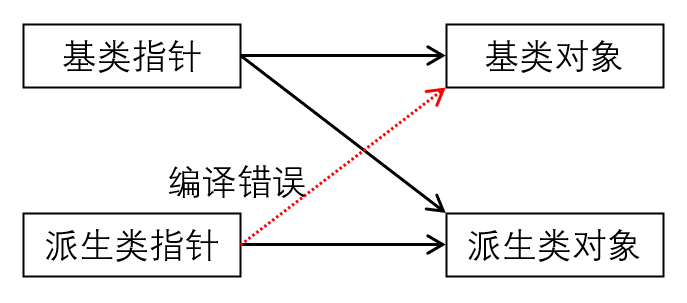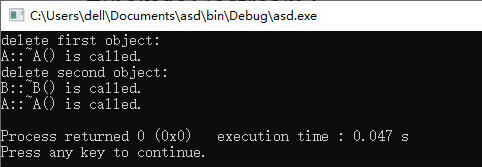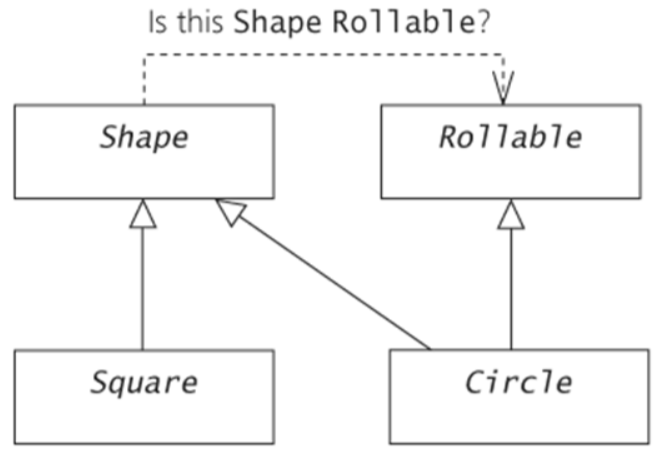C++多态
本章大纲
- 复制兼容
- 多态概念
- 虚函数
- 虚析构函数
- 抽象类和纯虚函数
- 强制转换
赋值兼容
赋值兼容规则:可以将公有派生类对象赋值给基类对象,反之是不允许的。

结果:将派生类对象中从基类继承来的成员赋给基类对象。
#include <iostream>
using namespace std;
class Point {
protected:
int x, y; // 保护成员
public:
Point(int a = 0, int b = 0) {
x = a;
y = b;
}
void Show() { cout << "point(" << x << "," << y << ")\n"; }
};
class Line : public Point // 公有继承
{
protected:
int x1, y1;
public:
Line(int a, int b, int c, int d)
: Point(a, b) // 调用基类构造函数
{
x1 = c;
y1 = d;
}
};
int main() {
Line line(2, 2, 6, 6);
Point p;
p = line; // A
p.Show();
return 0;
}
//输出:
point(2,2)赋值兼容要点:
派生类对象可以赋值给基类对象,系统将派生类对象中从基类继承来的成员赋给基类对象
不能将基类对象赋值给派生类对象
私有或保护继承的派生类对象,不可以赋值给基类对象。
可将派生类对象的地址赋给基类指针变量。例
Point *ptr = &line;派生类对象可初始化基类的引用。例如
Point &refp = line;在后两种情况下,使用基类指针或引用时,只能访问从相应基类中继承来的成员,而不允许访问其他基类成员或派生类中增加的成员。
多态概念
多态性是指发出同样的消息被不同类型的对象接收时有可能导致完全不同的行为。
多态的实现
在C++程序设计中, 多态的实现
- 函数重载
- 运算符重载
- 虚函数
多态分类
编译时多态
在程序编译时系统就能决定调用的是哪个函数。
函数重载
运算符重载
运行时多态
通过继承关系和虚函数来实现。
在程序执行前,无法根据函数名和参数来确定该调用哪一个函数,必须在程序执行过程中,根据执行的具体情况来动态地确定。
类继承层次中指针和对象之间的关系
基类指针、派生类指针、基类对象、派生类对象 之间的4种关系:
- 直接用基类指针指向基类对象
- 直接用派生类指针指向派生类对象
- 派生类对象给基类指针赋值(基指针指向派对象)
- 基类对象给派生类指针赋值。(编译会出错)

virtual函数(虚函数)
#include <iostream>
using namespace std;
class B0 // 基类B0声明
{
public:
// 外部接口
void display() { cout << "B0::display()" << endl; }
};
class B1 : public B0 // 公有派生
{
public:
void display() { cout << "B1::display()" << endl; }
};
class D1 : public B1 // 公有派生
{
public:
void display() { cout << "D1::display()" << endl; }
};
void fun(B0 *ptr) // 普通函数
{
ptr->display();
}
int main() // 主函数
{
B0 b0, *p;
// 声明基类对象和指针
B1 b1, *q;
// 声明派生类对象
D1 d1;
// 声明派生类对象
p = &b0;
q = &b1;
fun(q);
fun(p);
p = &b1;
fun(p);
p = &d1;
fun(p);#include <iostream>
using namespace std;
class Base { // 基类Base声明
public:
// 外部接口
void display() { cout << "Base::display()" << endl; }
};
class B1 : public Base { // 公有派生
public:
void display() { cout << "B1::display()" << endl; }
};
class D1 : public B1 { // 公有派生
public:
void display() { cout << "D1::display()" << endl; }
};
void fun(Base *ptr) { // 普通函数
ptr->display();
}
int main() {
// 声明基类对象和指针
Base base, *ptr_base;
// 声明派生类对象
B1 b1, *ptr_b1;
// 声明派生类对象
D1 d1;
ptr_base = &base;
ptr_b1 = &b1;
fun(ptr_b1); // Base::display()
fun(ptr_base); // Base::display()
ptr_base = &b1;
fun(ptr_base); // Base::display()
ptr_base = &d1;
fun(ptr_base); // Base::display()
}- 若将派生类对象的地址赋给指向基类的指针(基指派),则用该指针仅能访问派生类中从基类继承来的公有成员,通过指针引起的普通成员函数调用,仅仅与指针的类型有关,而与指针正指向什么对象无关。在这种情况下,必须采用显式的方式调用派生类的函数成员。
- (虚函数引入背景)本来使用对象指针是为了表达一种动态的性质,即当指针指向不同对象时执行不同的操作,现在看来并没有起到这种作用。要实现这种功能,就需要引入虚函数的概念。
C++ 类中使用关键字virtual 修饰的成员函数
virtual <数据类型> <函数名> (形参表)
{
函数体
}
virtual <函数返回值> <函数名>(形参表);- 本质:**是覆盖(override)**而不是重载(overload)声明。
- 虚函数是动态绑定的基础。是非静态的成员函数。
- 在类的声明中,在函数原型之前写virtual。virtual 只用来说明类声明中的原型,不能用在函数实现时。
- 一个函数一经说明为虚函数,则无论说明它的类被继承了多少层,在每一层派生类中该函数将永远保持其 virtual 特性。
- 具有继承性,基类中声明了虚函数,派生类中无论是否说明,同原型函数都自动为虚函数。
- 当基类中的某个成员函数被声明为虚函数后,此虚函数就可以在一个或多个派生类中被重新定义,在派生类中重新定义时,其函数原型,包括返回类型、函数名、参数个数、参数类型以及参数的顺序都必须与基类中的原型完全相同。
定义虚函数的目的
**为了让派生类覆盖(Overriding)它。**覆盖不同于重载,它要求重新定义的函数在参数和返回值方面与原函数完全相同。否则将属于重载(参数不同)或导致一个编译错误(返回值类型不同)。与函数重载相同,虚函数也体现了 OOP 技术的多态性。

- 一组虚函数中,两个虚函数仅返回值不同,参数和名字相同,编译报错。
虚函数调用方式
通过基类指针或引用,执行时会根据指针指向的对象的类,决定调用哪个函数。
#include <iostream>
using namespace std;
class B0 // 基类B0声明
{
public: // 外部接口
virtual void display() // 虚成员函数
{
cout << "B0::display()" << endl;
}
};
class B1 : public B0 // 公有派生
{
public:
void display() { cout << "B1::display()" << endl; }
};
class D1 : public B1 // 公有派生
{
public:
void display() { cout << "D1::display()" << endl; }
};
void fun(B0 *ptr) // 普通函数
{
ptr->display();
}
int main() // 主函数
{
B0 b0, *p; // 声明基类对象和指针
B1 b1, *q; // 声明派生类对象
D1 d1; // 声明派生类对象
p = &b0;
q = &b1;
fun(q);
fun(p); // 调用基类B0函数成员
p = &b1;
fun(p); // 调用派生类B1函数成员
p = &d1;
fun(p); // 调用派生类D1函数成员
}#include <iostream>
using namespace std;
class base
{
public:
virtual void fun1()
{
cout<<"base fun1"<<endl;
}
virtual void fun2()
{
cout<<"base fun2"<<endl;
}
void fun3()
{
cout<<"base fun3"<<endl;
}
void fun4()
{
cout<<"base fun4"<<endl;
}
};
class derived:public base
{
virtual void fun1()
{
cout<<"derived fun1"<<endl;
}
void fun2()
{
cout<<"derived fun2"<<endl;
}
virtual void fun3()
{
cout<<"derived fun3"<<endl;
}
void fun4()
{
cout<<"derived fun4"<<endl;
}
};
void main()
{
base *pb;
derived d;
pb=&d;
pb->fun1();
pb->fun2();
pb->fun3();
pb->fun4();
}基类与派生类中有同名函数:
#include <iostream>
#include <string>
using namespace std;
// 声明基类Student
class Student {
public:
Student(int, string, float); // 声明构造函数
virtual void display(); // 声明输出函数
protected: // 受保护成员,派生类可以访问
int num;
string name;
float score;
};
// Student类成员函数的实现
Student::Student(int n, string nam, float s) // 定义构造函数
{
num = n;
name = nam;
score = s;
}
void Student::display() // 定义输出函数
{
cout << "num:" << num << "\nname:" << name << "\nscore:" << score << "\n\n";
}
// 声明公用派生类Graduate
class Graduate : public Student {
public:
Graduate(int, string, float, float); // 声明构造函数
void display(); // 声明输出函数
private:
float pay;
};
// Graduate类成员函数的实现
void Graduate::display() // 定义输出函数
{
cout << "num:" << num << "\nname:" << name << "\nscore:" << score
<< "\npay=" << pay << endl;
}
Graduate::Graduate(int n, string nam, float s, float p)
: Student(n, nam, s), pay(p){}; // 主函数
int main() {
Student stud1(1001, "Li", 87.5);
Graduate grad1(2001, "Wang", 98.5, 563.5);
Student *pt = &stud1; // 定义指向基类对象的指针变量pt
pt->display();
pt = &grad1;
pt->display();
return 0;
}由虚函数实现的动态多态性:同一类族中不同类的对象,对同一函数调用作出不同的响应。
虚函数的使用方法
- 在基类用virtual声明成员函数为虚函数。在类外定义虚函数时,不能加virtual,会报错。
- 在派生类中重新定义此函数。要求函数名、函数类型、函数参数个数和返回类型全部与基类的虚函数相同,并根据派生类的需要重新定义函数体。
- 定义一个指向基类对象的指针变量,并使它指向同一类族中需要调用该函数的对象。
- 通过该指针变量调用此虚函数,此时调用的就是指针变量指向的对象的同名函数。
- C++规定,当一个成员函数被声明为虚函数后,其派生类中的同名函数都自动成为虚函数。因此在派生类重新声明该虚函数时,可以加virtual,也可以不加,一般在每一层声明该函数时都加virtual,使程序更加清晰。
- 如果在派生类中没有对基类的虚函数重新定义,则派生类简单地继承其直接基类的虚函数。
- 通过虚函数和指向基类对象的指针变量,能够方便地调用同一类族中不同类的同名函数,只要先用基类指针指向对应的派生类即可。
说明:
- 函数重载处理的是同一层次上的同名函数问题,而虚函数处理的是不同派生层次上的同名函数问题,前者是横向重载,后者可以理解为纵向重载。
- 与重载不同的是: 同一类族的虚函数的首部是相同的,而函数重载时函数的首部是不同的(参数个数或类型不同)。
虚析构函数
使用场景
- 通过基类指针删除派生类对象时
- 如果允许通过基类指针调用对象的析构函数(即delete 基类指针),并且被析构的对象是有析构函数的派生类的对象,就需要将基类的析构函数成为虚析构函数。
When
派生类含有指针类型数据成员。
Why
避免内存泄漏:delete 指向派生类对象的基类指针时自动调用子类的析构函数释放派生类对象已申请的堆内存,从而防止内存泄露。
语法:virtual ~ ClassName(){}
#include <iostream>
using namespace std;
class A {
public:
~A() { cout << "A::~A() is called.\n"; }
};
class B : public A {
public:
~B() { cout << "B::~B() is called.\n"; }
};
int main() {
A *Ap = new B;
B *Bp2 = new B;
cout << "delete first object:\n";
delete Ap;
cout << "delete second object:\n";
delete Bp2;
}
#include <iostream>
using namespace std;
class A {
public:
virtual ~A() { cout << "A::~A() is called.\n"; }
};
class B : public A {
public:
~B() { cout << "B::~B() is called.\n"; }
};
int main() {
A *Ap = new B;
B *Bp2 = new B;
cout << "delete first object:\n";
delete Ap;
cout << "delete second object:\n";
delete Bp2;
}
- 定义了基类虚析构函数,基类指针指向的派生类动态对象也可以正确地用delete析构
- 设计类层次结构时,提供一个虚析构函数,能够使派生类对象在不同状态下正确调用析构函数
虚函数的限制
如果将所有的成员函数都设置为虚函数,当然是很有益的。它除了会增加一些额外的资源开销,没有什么坏处。但设置虚函数须注意以下几点:
- 只有才能声明为虚函数。因为虚函数仅适用于有继承关系的类对象,所以普通函数不能声明为虚函数。
- 虚函数必须是。这是因为静态成员函数不受限于某个对象
- 声明为虚函数。因为内联函数不能在运行中动态确定其位置
- 声明为虚函数。多态是指不同的对象对同一消息有不同的行为特性。虚函数作为运行过程中多态的基础,主要是针对对象的,而构造函数是在对象产生之前运行的,因此,虚构造函数是没有意义的。
- 声明为虚函数。析构函数的功能是在该类对象消亡之前进行一些必要的清理工作。析构函数没有类型,也没有参数,和普通成员函数相比,虚析构函数情况略为简单些。
#include <cstring>
#include <iostream>
using namespace std;
class base {
char *baseptr;
public:
base() {
baseptr = new char[100];
strcpy(baseptr, "In class base");
fc();
}
virtual void fc() // D
{
cout << baseptr << endl;
}
virtual ~base() // E
{
delete[] baseptr;
cout << "Delete [ ]baseptr" << endl;
}
};
class A : public base {
char *Aptr;
public:
A() {
Aptr = new char[100];
strcpy(Aptr, "In class A");
fc(); // F
}
void f() {
fc(); // G
}
~A() {
delete[] Aptr;
cout << "Delete [ ]Aptr" << endl;
}
};
class B : public A {
char *Bptr;
public:
B() {
Bptr = new char[100];
strcpy(Bptr, "In class B");
}
void fc() { cout << Bptr << endl; }
~B() {
delete[] Bptr;
cout << "Delete [ ]Bptr" << endl;
}
};
void main(void) {
B b; // H
b.f(); // K
base *p = new B; // M
delete p; // N
}抽象类和纯虚函数
带有纯虚函数的类称为抽象类。
虚函数为一个类体系中所有类提供了一个统一的接口。然而在有些情况下,定义基类时虽然知道其子孙类应当具有某一接口,但其自身由于某种原因却无法实现该接口,换句话:
- 它在该基类中没有定义具体的操作内容。这里就应将该接口说明成一个纯虚函数,其具体操作由各子孙类来定义
纯虚函数:
class 类名 {
virtual 类型 函数名(参数表) = 0; // 纯虚函数
//...
}
//纯虚函数与一般虚函数在书写形式上的不同在于其后面加了"=0",
//表明在基类中不用定义该函数,它的实现部分——函数体留给派生类去做。抽象类的作用
- 抽象类为抽象和设计的目的而声明,将有关的数据和行为组织在一个继承层次结构中,保证派生类具有要求的行为。
- 对于暂时无法实现的函数,可以声明为纯虚函数,留给派生类去实现。
抽象类的注意事项
- 抽象类只能作为基类来使用,不能声明抽象类的对象。
- 抽象类不能用作参数类型、函数返回值或显式转换的类型。
- 可以声明一个抽象类的指针和引用。通过指针或引用,可以指向并访问派生类对象,以访问派生类的成员。
- 抽象类派生类
- 若派生类给出所有纯虚函数的函数实现,这个派生类就可以声明自己的对象,因而不再是抽象类
- 若派生类没有给出全部纯虚函数的实现,这时的派生类仍然是一个抽象类
#include <iostream>
using namespace std;
const double PI = 3.14159;
class Shapes // 抽象基类Shapes声明
{
protected:
int x, y;
public:
void setvalue(int xx, int yy = 0) {
x = xx;
y = yy;
}
virtual void display() = 0; // 纯虚函数成员
};
class Rectangle : public Shapes // 派生类Rectangle声明
{
public: // 虚成员函数
void display() { cout << "The area of rectangle is: " << x * y << endl; }
};
class Circle : public Shapes // 派生类Circle声明
{
public: // 虚成员函数
void display() { cout << "The area of circle is: " << PI * x * x << endl; }
};
int main() {
Shapes *ptr[2]; // 声明抽象基类指针
Rectangle rect1;
Circle cir1;
ptr[0] = &rect1; // 指针指向Rectangle类对象
ptr[0]->setvalue(5, 8);
ptr[0]->display();
ptr[1] = &cir1; // 指针指向Circle类对象
ptr[1]->setvalue(10);
ptr[1]->display();
}应用实例:虚函数和抽象基类的应用。介绍了以Point为基类的点—圆—圆柱体类的层次结构。
#include <iostream>
using namespace std;
class Shape // 声明抽象基类Shape
{
public:
virtual float area() const {
return 0.0; // 虚函数
}
virtual float volume() const {
return 0.0; // 虚函数
}
virtual void shapeName() const = 0; // 纯虚函数
};
// 声明Point类
class Point : public Shape // Point是Shape的公用派生类
{
public:
Point(float = 0, float = 0);
void setPoint(float, float);
float getX() const { return x; }
float getY() const { return y; }
virtual void shapeName() const // 对虚函数进行再定义
{
cout << "Point:";
}
friend ostream &operator<<(ostream &, const Point &);
protected:
float x, y;
};
// 定义Point类成员函数
Point::Point(float a, float b) {
x = a;
y = b;
}
void Point::setPoint(float a, float b) {
x = a;
y = b;
}
ostream &operator<<(ostream &output, const Point &p) {
output << "[" << p.x << "," << p.y << "]";
return output;
}
// 声明Circle类
class Circle : public Point {
public:
Circle(float x = 0, float y = 0, float r = 0);
void setRadius(float);
float getRadius() const;
virtual float area() const;
virtual void shapeName() const {
cout << "Circle:"; // 对虚函数进行定义
}
friend ostream &operator<<(ostream &, const Circle &);
protected:
float radius;
};
// 声明Circle类成员函数
Circle::Circle(float a, float b, float r) : Point(a, b), radius(r) {}
void Circle::setRadius(float r) : radius(r) {}
float Circle::getRadius() const { return radius; }
float Circle::area() const { return 3.14159 * radius * radius; }
ostream &operator<<(ostream &output, const Circle &c) {
output << "[" << c.x << "," << c.y << "], r=" << c.radius;
return output;
}
// 声明Cylinder类
class Cylinder : public Circle {
public:
Cylinder(float x = 0, float y = 0, float r = 0, float h = 0);
void setHeight(float);
virtual float area() const;
virtual float volume() const;
virtual void shapeName() const // 对虚函数进行再定义
{
cout << "Cylinder:";
}
friend ostream &operator<<(ostream &, const Cylinder &);
protected:
float height;
};
// 定义Cylinder类成员函数
Cylinder::Cylinder(float a, float b, float r, float h)
: Circle(a, b, r), height(h) {}
void Cylinder::setHeight(float h) { height = h; }
float Cylinder::area() const {
return 2 * Circle::area() + 2 * 3.14159 * radius * height;
}
float Cylinder::volume() const { return Circle::area() * height; }
ostream &operator<<(ostream &output, const Cylinder &cy) {
output << "[" << cy.x << "," << cy.y << "], r=" << cy.radius
<< ", h=" << cy.height;
return output;
}
// main函数
int main() {
Point point(3.2, 4.5); // 建立Point类对象point
Circle circle(2.4, 1.2, 5.6); // 建立Circle类对象circle
Cylinder cylinder(3.5, 6.4, 5.2, 10.5); // 建立Cylinder类对象cylinder
point.shapeName(); // 静态关联
cout << point << endl;
circle.shapeName(); // 静态关联
cout << circle << endl;
cylinder.shapeName(); // 静态关联
cout << cylinder << endl << endl;
Shape *pt; // 定义基类指针
pt = &point; // 指针指向Point类对象
pt->shapeName(); // 动态关联
cout << "x=" << point.getX() << ",y=" << point.getY()
<< "\\narea=" << pt->area() << "\\nvolume=" << pt->volume() << "\\n\\n";
pt = &circle; // 指针指向Circle类对象
pt->shapeName(); // 动态关联
cout << "x=" << circle.getX() << ",y=" << circle.getY()
<< "\\narea=" << pt->area() << "\\nvolume=" << pt->volume() << "\\n\\n";
pt = &cylinder; // 指针指向Cylinder类对象
pt->shapeName(); // 动态关联
cout << "x=" << cylinder.getX() << ",y=" << cylinder.getY()
<< "\\narea=" << pt->area() << "\\nvolume=" << pt->volume() << "\\n\\n";
return 0;
}一些结论:
- 含有1个及以上纯虚(成员)函数的基类是抽象基类,抽象基类不能且没必要定义对象;
- 抽象基类一般并不是现实存在的对象的抽象(如圆形是千千万万个实际的圆的抽象),它可以没有任何物理上的或其他实际意义方面的含义;
- 在类的层次结构中,顶层或最上面的几层可以是抽象基类。抽象基类体现了本类族中各类的共性,把各类中共有的成员函数集中在抽象基类中声明;
- 抽象基类是本类族的公共接口。或者说,从同一基类派生出的多个类有同一接口;
- 如果在基类声明了虚函数,则在派生类中凡是与该函数有相同的函数名、函数返回类型、参数个数和类型的函数,均为虚函数(不论在派生类中是否用virtual声明);
- 区别静态关联和动态关联。
强制转换
dynamic_cast
关键字dynamic_cast(动态强制转换):操作符dynamic_cast将一个指向基类的指针转换为一个指向派生类的指针(如果不能正确转换,则返回0——空指针)。

class Shape {
public: virtual ~Shape();
virtual void draw() const = 0;
};
class Rollable {
public: virtual ~Rollable();
virtual void roll() = 0;
};
class Circle : public Shape, public Rollable {
void draw() const;
void roll();
};
class Square : public Shape {
void draw() const;
};
//横向转型失败
Shape *pShape1 = new Square();
Rollable *pRollable1 = dynamic_cast<Rollable*>(pShape1);
//pRollable为NULL
//横向转型成功
Shape *pShape2 = new Circle();
Rollable *pRollable2 = dynamic_cast<Rollable*>(pShape2);
//pRollable不为NULL例子:设计shape类层次结构。每个TwoDShape类都包含成员函数getArea,用于计算二维形状的面积。每个ThreeDShape类都包含成员函数getArea和getVolume,分别用于计算三维形状的表面积和体积。编写一个程序,使用一个Shape指针的vector对象,他的元素指向类层次总每个具体类的对象。 程序打印输出该vector对象的所有形状循环中,程序应判断每个形状是二维形状还是三维形状,如果是二维形状,显示面积,如果是三维形状,显示表面积和体积。